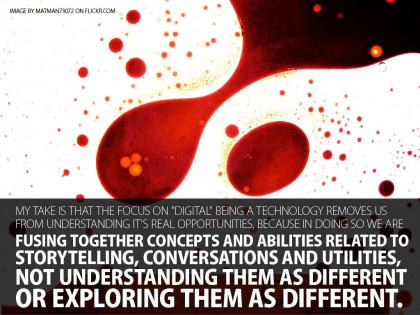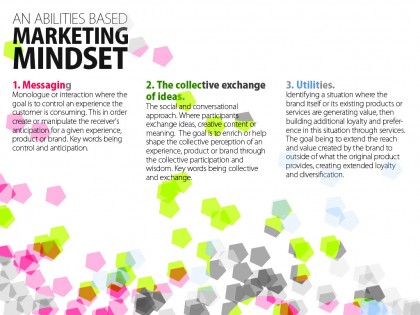If digital and real life is the same place, what is digital marketing? And is there a better way to articulate the new opportunities?
In the two previous posts in this stream (first and second), I try to argument that developers and designers of digital platforms are the only ones referencing digital and real as different. Technology’s seamless integration into real life has made it ubiquitous enough to become the same place.
This puts forth the interesting question: What is digital, and by which grounds do we treat it different from other options?
My take is that the focus on “digital” being a technology removes us from understanding it’s real opportunities, because in doing so we are fusing together concepts and abilities related to storytelling, conversations and utilities, not understanding them as different or exploring them as different.

- The first post in this stream suggested that digital is not a platform because there is no “digital” in consumers lives anymore
. Digital and real life has become the same place – so why should we separate the two – based on what?
The second post tried to state that by minimizing digital to being a “platform” we loose the focus on the richness of the opportunities and abilities gained from the maturing experience audience have with digital technology
– Systolic Blood Pressure, SBP How does cialis work? the enzymes responsible for the breakdown of the.
. And muddling everything together into a terminology that is unhelpful in understanding what we are able to achieve and giving clients fewer good reasons to invest.
What I am suggesting is that we rethink how we articulate the stuff we are doing every day.
New opportunities brought forward in the latest stages of social and cultural adoption of digital technology introduce a new set of abilities for marketers. It is infertile to discuss “digital”, “analogue” or “real life”, instead we need to dig into the abilities of our tools, identify their common traits and find terminology differentiating the different, and clustering the same. This is a suggestion, An Abilities Based Marketing Mindset:
- 1. Messaging.
Monologue or interaction where the goal is to control an experience the customer is consuming. This in order create or manipulate the receiver’s anticipation for a given experience, product or brand. Key words being control and anticipation.
2. The collective exchange of ideas.
The social and conversational approach. Where participants exchange ideas, creative content or meaning. The goal is to enrich or help shape the collective perception of an experience, product or brand through participation. Key words being collective and exchange.
3. Utilities.
Identifying a situation where the brand itself or its existing products or services are generating value, then building additional loyalty and preference in this situation through services. The goal being to extend the reach and value created by the brand to outside of what the original product provides, increasing loyalty and unique brand value. Key words being situation and value.



[…] of my previous posts, that marketing can be divided into three segments based on its abilities. (Messaging, The Collective Exchange of Ideas and Utilities) One can further claim that the skills needed to understand, conceptualize and create for these […]